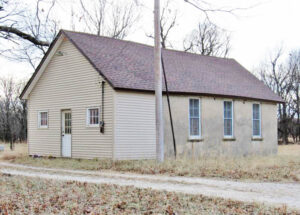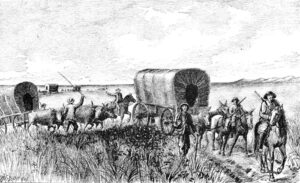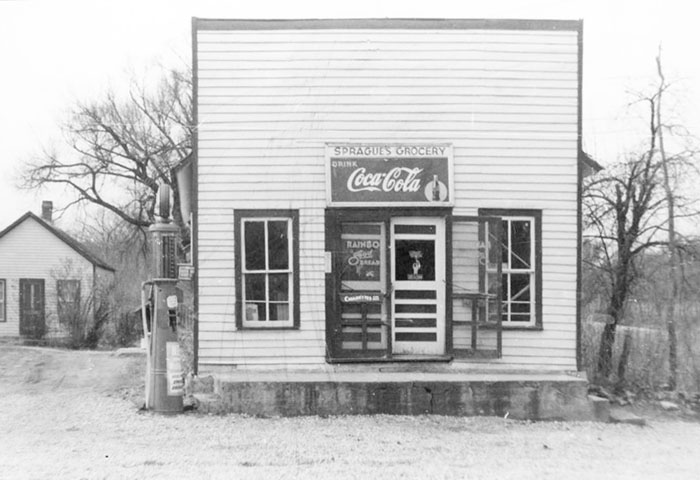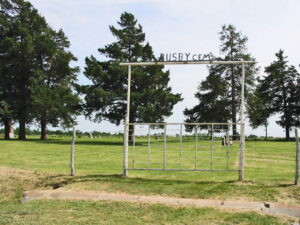Busby, Kansas, is an extinct town in Painterhood Township, near Middle Painterhood Creek on the main road between Howard and Fredonia.
Before 1877, a school preceded the town of Busby. The stone school building also served as a community center. The building still stands with an outhouse and merry-go-round on Limestone Road. Its interior is still neat and well-kept, and the community continues to use it.
The Busby School District was a large one. At one time, the one-room school boasted 140 registered students. Many attended until age 21, but the average daily attendance was generally small because children were kept home until all crops were harvested in the fall. They dropped out again the following February or March for the spring plowing and planting. Bad roads and severe weather hampered many from attending. Although some attended until age 21, many did not complete the 8th grade.
School terms were usually five months, although sometimes the school board saw fit to hire a teacher for a spring term of two months. Wages for the teacher were generally $25 to $35 a month. Parents of students sometimes “boarded” the teacher for a week or two at a time.
The main road between Howard and Fredonia was busy, with many people passing through the area. It was not uncommon to find caravans of covered wagons containing all their owners’ belongings and people in buggies and bands of gypsies. They often stayed some time to rest their animals, repair their vehicles, and restock their supplies. Even medicine shows stopped at Busby, featuring nightly entertainment while making a few dollars peddling their remedies.
A campground was in an oak grove behind the schoolhouse. The location was ideal, with water nearby and two general stores providing supplies. No bridge crossed the creek then, and it was easy to water animals. It was common for some of the local townspeople to visit around the evening campfire with the travelers and catch up on news from the outside world.
The first three settlers were said to be James Howe in West Painterhood Township in 1868, Barnes in Middle Painterhood, and Isam Conner in East Painterhood. There were also Davises, Hawkins, McCulloughs, and others.
A town called Amy sprouted up around the school, and a post office was established on March 3, 1884. It was located in a beautiful and fertile small valley surrounded by rough countryside. The valley was unusual because it had a few artesian wells, one on the school grounds. The town’s name was changed to Busby on January 12, 1885, for Ruben Busby, a blacksmith and one of the early settlers. His shop stood across the road northeast from the Busby store. When the Busbys moved to Oak Valley, the shop stood empty while the John Sutton family came and operated it. They were natives of Kentucky.
Perry and Flora Sprague and their children came to Busby in 1885. Perry had moved his family to the area so he could seek relief from painful rheumatism. His five children attended school at Busby, and the family ran the Busby Store. The post office, served by a star route from Longton, was then moved to the store. It became a meeting place for 20 years for all the post office patrons.
The Busby Store remained in the Sprague family for almost three-fourths of a century. The store carried a general line of goods that most travelers and settlers needed to replenish their larders. Flour was hauled from the Longton Mill when it was operating. Later, it was hauled from Fredonia. The trip would begin about four o’clock in the morning and be completed about nine o’clock that night. Other freight was ordered from Independence and shipped by train to Longton. From there, it was hauled by horses and wagon to Busby. The Spragues claim no one who needed food or help was ever turned away. Perry Sprague never had a recurrence of his rheumatic affliction and never left Busby. After Perry died at 89 in 1935, his wife took over until her health failed. Then, their son, Warren, operated it until his health also failed. In September 1959, the goods were sold from the store. Later, in 1960, the Elk County Commissioners forced the sale of the land to the county for road improvement. The buildings were razed, and an important landmark was destroyed.
Other early settlers were part of a Swedish group who settled at Busby, including N.J. Lindelow and his wife, who lived in a stone house, and Barant Olson, who lived one mile north of Busby, his brother, Alfred Olson, lived west of Busby and Gust Anderson, who lived on a farm about a mile north of the Busby store. He was responsible for some of the well-constructed stone buildings in the countryside and Longton. He was an ardent Mason and never missed a meeting, often riding a horse nine miles each way to attend in all kinds of weather. He served as Master several times.
Jonathan Lewis was one of the first settlers of the Middle Painterhood Creed. He took out and proved up on a claim in the late 1860s. This property was about one mile south of Busby. Indians were still around the area; in fact, Lewis’ land on the east side of the creek had once been an Indian campground. Mr. Lewis did much to keep things on an even keel in the community. He attended meetings to help establish the boundary lines of Elk County. He walked across the hills to Elk Falls to attend the first meeting held in 1870 to nominate officers for the Howard County Seat. Although this meeting was supposed to be a Republican convention, it was afterward learned that few Democrats had occupied seats as delegates. W.W. Hensley and Cyrus Tuggle of Painterhood Township also attended this meeting.
A railroad had been surveyed through Busby, and lots were laid out for a good-sized town. As this news became known to the outside world, people migrated to the area looking for work. Homes were built on nearly all the nearby 40-acre plots. Soon, there were two general stores, two blacksmith shops, a school, a hotel, and a church. A strong Anti-Horse Thief Association was organized. Years later, a cream station was added to the businesses.
The Hensely Hotel stood just south of the general store. Operated by the Hensley family, it served the need for a place to eat and sleep for people traveling by horse and buggy across the country. Busby was the only place on the main road between Howard and Fredonia where travelers could find a place to stay at a hotel or campground with good facilities. For many years, the hotel prospered.
At its peak, Busby had two general stores, two blacksmith shops, a hotel, a restaurant, a post office, a church building, and a schoolhouse.
Because of the long distances small children had to walk to school in the early days, patrons in the north half of the district asked that another district be established. The district of Cedar Summit was organized through much effort by interested parents. This district was located about two miles north of Busby and 1/4 mile south of the east and west road to Howard and Fall River on what was then the Cutter farm.
In 1906, the railroad veered off in another direction, and an exodus began. It was not long before the population dwindled. As the population decreased, there was no further need for the extra district, which was dissolved. On February 14, 1906, Busby’s post office closed, and the rural free delivery took over the mail delivered from Howard.
When telephones first came to this part of Kansas, Perry Sprague spent many long days organizing the Busby Telephone Company without pay. A constitution was adopted on March 4, 1907. The Longton Telephone Company would not build a line in the country, so the Busby Company erected its own lines and sold shares to pay the costs. In addition, each member was required to furnish 13 telephone poles, his telephone and sidelines, his labor, and $3.25 of his own money for supplies. Almost 30 people used this party line before it was divided into two lines for better service. Many years later, when stockholders moved away, the company was sold to the Longton Telephone Company.
In 1910, Busby had a population of 47. Buxton on the Atchison, Topeka & Santa Fe Railroad was the nearest railroad station in Wilson County.
In 1960, the enrollment in the Busby School was not large. Still, the students seemed happy and industrious under the tutelage of a female teacher with a good personality and an excellent understanding of teaching. At the time of the consolidation of rural schools, only about 12 students remained.
Busby was located about 12 miles east of Howard, Kansas, on 23 Road.
Also See:
Sources:
Blackmar, Frank W.; Kansas: A Cyclopedia of State History, Vol I; Standard Publishing Company, Chicago, IL 1912.
Dam, Eunice Sprague; Elk County, A Narrative History of Elk County and its People; Elk County Historical Society, 1979.
Find-a-Grave
Richards, W.M.; Some Ghost Towns of Kansas, Emporia State University




